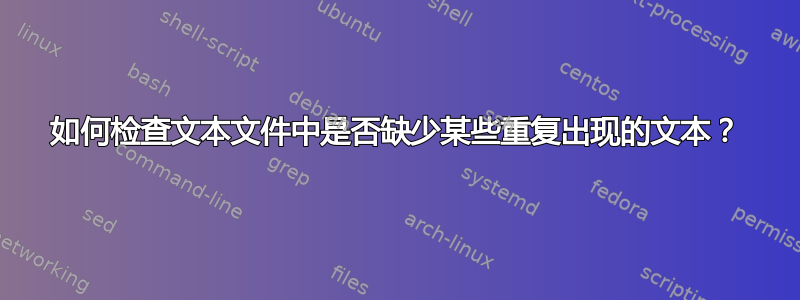
我有一个如下所示的文本文件:
{
"mimeType": "web",
"body": "adsfdf",
"data_source_name": "abc",
"format": "web",
"url": "http://google.com/",
"urls": "http://google.com/",
"lastModified": "123123",
"title": "Google",
"docdatetime_dt": "1231234",
"wfbdomain": "google.com",
"id": "http://google.com",
},
{
"mimeType": "web",
"body": "adsfdf",
"data_source_name": "zdf",
"format": "web",
"url": "http://facebook.com/",
"urls": "http://facebook.com/",
"lastModified": "123123",
"title": "Facebook",
"docdatetime_dt": "1231234",
"wfbdomain": "facebook.com",
"id": "http://facebook.com",
},
{
"mimeType": "web",
"body": "adsfdf",
"format": "web",
"url": "http://twitter.com/",
"urls": "http://twitter.com/",
"lastModified": "123123",
"title": "Twitter",
"docdatetime_dt": "1231234",
"wfbdomain": "twitter.com",
"id": "http://twitter.com",
}
如果您看到上面块中的第三个,您会注意到“数据源名称”:....不见了。我有一个非常大的文件,想检查这个特定的东西是否丢失,如果丢失,则打印/回显它。
我尝试过 sed 但无法弄清楚如何正确使用它。
是否可以使用 sed 或者其他东西?
答案1
使用 GNU awk,您可以用作}, {记录分隔符并打印不包含的记录"data_source_name"::
gawk -v RS='}\\s*,\\s*{' '!/"data_source_name":/'
或者您可以将其解码为它似乎使用的 json 类型JSON::PP:
perl -MJSON::PP -l -0777 -ne '
$j = JSON::PP->new->relaxed->pretty;
print $j->encode($_) for grep {!defined($_->{data_source_name})}
@{$j->decode("[$_]")}' < file.json
答案2
虽然awk在这种情况下使用似乎更合理,但您可以将 gnu 用作sed:
sed 'H;/}/{g;/data_source_name/!p;z;h};d'
描述:
#!/bin/sed -f
H # append each line to hold space
/}/ { # on each closing bracket
g # get contents of hold space to pattern space
/data_source_name/!p # print pattern space if it does not contain "data_source_name"
z;h # empty hold space
}
d
答案3
假设您的输入是有效的 JSON 对象数组,
$ jq '.[] | select(has("data_source_name")|not)' file
{
"mimeType": "web",
"body": "adsfdf",
"format": "web",
"url": "http://twitter.com/",
"urls": "http://twitter.com/",
"lastModified": "123123",
"title": "Twitter",
"docdatetime_dt": "1231234",
"wfbdomain": "twitter.com",
"id": "http://twitter.com"
}
这使用命令行解析器jq输出所有没有data_source_name键的对象。
是什么使您的数据无效 JSON (因为我认为您已经针对问题修改了它)是它缺少周围的内容[ ... ],并且在每个对象的最后一个值的末尾(每个终止之前)都有尾随逗号}。
如果您的 JSON 输入是放对象(没有周围的对象[ ... ],它们之间没有逗号,并且每个终止之前没有尾随逗号}),然后仅使用select()表达式中的语句就可以了。即,您将删除.[],它仅用于从数组中提取对象。


